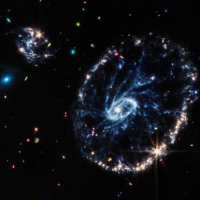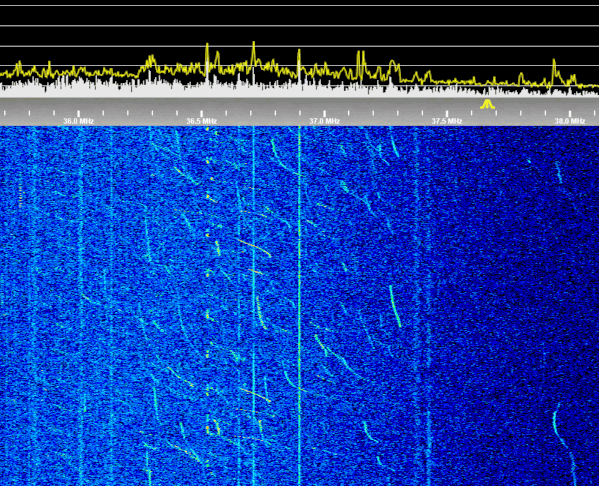G8JNJ
About
- Username
- G8JNJ
- Joined
- Visits
- 4,657
- Last Active
- Roles
- Member
- Points
- 129
Reactions
-
Surprised by interference.
Hi Trevor,
I don't think you need a filter, you have more than enough gain ahead of the KiWi, that allows you to simply add broadband attenuation.
You don't need massively strong signals to achieve good reception, you just need to get the balance right.
Once the overload is sorted out, which I think confused the issue, you can then start dealing with the remaining interference.
The pulsing noise that can be heard using AM demodulation, between about 15 and 26MHz is a Ethernet data over mains extender, and hopefully you may be able to null that out to a certain extent.
There is some noise with 50/100Hz modulation around 3MHz and other frequencies, which is probably a mains powered charger or some other similar electrical item. However, that is at a fairly low level and isn't causing major problems.
Overall, I'd say it's pretty typical of reception in a UK urban environment, and I think you would have to live in a much more rural location to obtain significantly better results.
When I moved from a quiet rural location, back into a town, my noise floor was about 20dB worse using the same types of antennas.
Regards,
Martin
-
Surprised by interference.
Hi Trevor,
I don't think your situation is quite as bad as you think it is.
I'd suggest sorting out the main issue first.
Your loop is providing quite high signal levels, and the two strong medium wave stations on 693 & 1053kHz are almost certainly causing some intermodulation products over the rest of the MW band, and maybe beyond.
Try adding 10dB of attenuation and see if this improves things.
In fact, you could probably add as much as 20dB, without degrading the Signal To Noise Ratio.
The antenna only needs to raise the noise floor by 6 to 10dB on the quietest of frequencies, which are probably those above 25MHz.
Adding 10dB of attenuation should reduce all the signals by 10dB, if some reduce by a greater amount, or disappear completely, then they are likely to be false signals produced as intermodulation distortion.
If intermodulation products remain, then the loop amplifier is being overloaded, and a smaller loop may be required.
Regards,
Martin
-
VDSL filter for the Kiwi SNR measurement
Ah OK, however it would be interesting to see if John's filter, also responds to broadband noise that looks like VDSL.
I wonder if there are several consecutive FFT bins, that contain the same level, could this be interpreted as wideband noise rather than individual signals, and treated as such in the SNR calculation ?
Regards,
Martin
-
What are these downchirp transmissions ?
These are typical of RF welding / Drying / Curing processes. Very high power RF sources are also used during some types of semiconductor manufacturing processes.
Another source, is from the cheap Chinese "Radio Frequency Facial Machine" or "wands". These typically produce between 5 to 25 watts, but some are rated at several hundred watts.
All of the above can usually be observed around most of the ISM allocations, and they are a good propagation indicator on the low VHF bands.
Here are a few that should really be in the 40MHz ISM band, most likely from Asia.
When I used to live in an industrial town, we had one in a factory that welded seams on industrial clothing, that operated on 27MHz, and the Interference Investigators were forever chasing the owners, as they often removed safety covers, so that they could run the machine for longer before it overheated. The stray RF signals and harmonics used to interfere with the 2m amateur band and local taxi services over a very large radius. Once you have heard the distinctive warbling, humming, and drifting signals, you can easily spot them again.
Regards,
Martin
-
Very wideband FSK(?) on 40m
Well done on the TDoA, especially as it doesn't work too well on CW or FSK. I made several TDoA runs during grey line propagation, and initially thought it was from Germany. I should have known better. I used two separate browser instances with my KiWi, with the frequencies offset to produce a composite, but much narrower shift FSK signal, that I could attempt to read with an external decoder. However, the data is encrypted, as you would expect for a military signal.
The pair on 7043/7050 kHz shift to 7041.5/7048.5 kHz
The pair on 7063/7070 kHz shift to 7061.5/7068.5 kHz
Reports and discussion suggest it's a Russian FSK transmission, with some reports suggesting it's coming from somewhere in the Urals or the heart of Siberia, but one more detailed report suggests that the source is in the Crimea near Sevastopol ( https://youtu.be/zRho2iFfBCE )
--- Text from YouTube video---
Sevastopol; Extremely powerful two channel 20b/7000 Hz FSK paired signals re-appear from Apr 23rd on 40m band ~ 7045cf and 7065.5cf, each channel seems to be 7 kHz from mark and space, chosen for it's immunity from being easily jammed, at times the pair will shift frequency; originating from Eastern EU / Western RU region, now Crimea with transmitters near Sevastopol. The modulation rate of 20b with a shift of 7000 Hz.
-The signal frame is 17 bits, the first of which is a 0.
-The superframe is 15 frames (255 bits) and is constantly repeated so it does not appear to carry any useful information
Military encryption 5N1 use in related signal connection to the conflict between Ukraine and Russia is likely. Contributor ANgazu thank you for your analysis!
---
This link has a similar discussion and explanation as to these signals:
https://reflector.sota.org.uk/t/some-weird-cw-found-on-40m/38289?u=iu1kgs








